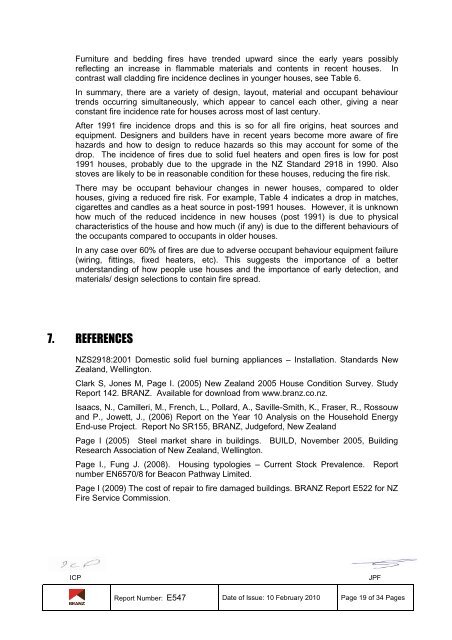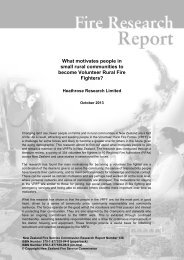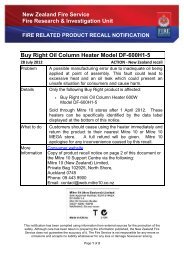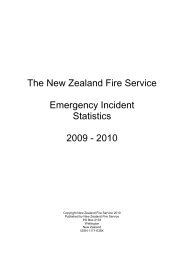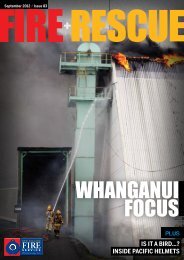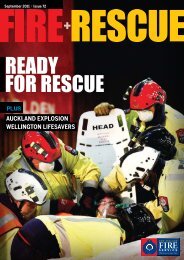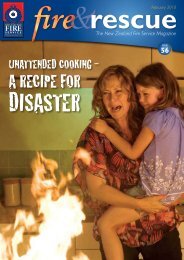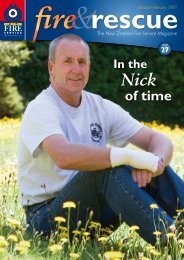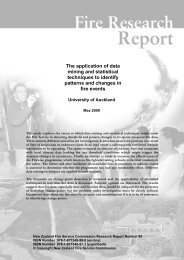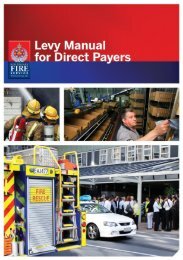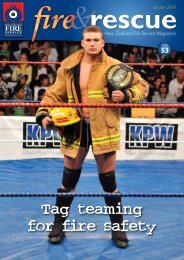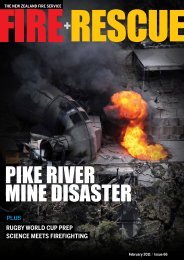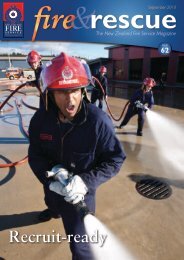Download PDF - New Zealand Fire Service
Download PDF - New Zealand Fire Service
Download PDF - New Zealand Fire Service
You also want an ePaper? Increase the reach of your titles
YUMPU automatically turns print PDFs into web optimized ePapers that Google loves.
Furniture and bedding fires have trended upward since the early years possibly<br />
reflecting an increase in flammable materials and contents in recent houses. In<br />
contrast wall cladding fire incidence declines in younger houses, see Table 6.<br />
In summary, there are a variety of design, layout, material and occupant behaviour<br />
trends occurring simultaneously, which appear to cancel each other, giving a near<br />
constant fire incidence rate for houses across most of last century.<br />
After 1991 fire incidence drops and this is so for all fire origins, heat sources and<br />
equipment. Designers and builders have in recent years become more aware of fire<br />
hazards and how to design to reduce hazards so this may account for some of the<br />
drop. The incidence of fires due to solid fuel heaters and open fires is low for post<br />
1991 houses, probably due to the upgrade in the NZ Standard 2918 in 1990. Also<br />
stoves are likely to be in reasonable condition for these houses, reducing the fire risk.<br />
There may be occupant behaviour changes in newer houses, compared to older<br />
houses, giving a reduced fire risk. For example, Table 4 indicates a drop in matches,<br />
cigarettes and candles as a heat source in post-1991 houses. However, it is unknown<br />
how much of the reduced incidence in new houses (post 1991) is due to physical<br />
characteristics of the house and how much (if any) is due to the different behaviours of<br />
the occupants compared to occupants in older houses.<br />
In any case over 60% of fires are due to adverse occupant behaviour equipment failure<br />
(wiring, fittings, fixed heaters, etc). This suggests the importance of a better<br />
understanding of how people use houses and the importance of early detection, and<br />
materials/ design selections to contain fire spread.<br />
7. REFERENCES<br />
NZS2918:2001 Domestic solid fuel burning appliances – Installation. Standards <strong>New</strong><br />
<strong>Zealand</strong>, Wellington.<br />
Clark S, Jones M, Page I. (2005) <strong>New</strong> <strong>Zealand</strong> 2005 House Condition Survey. Study<br />
Report 142. BRANZ. Available for download from www.branz.co.nz.<br />
Isaacs, N., Camilleri, M., French, L., Pollard, A., Saville-Smith, K., Fraser, R., Rossouw<br />
and P., Jowett, J., (2006) Report on the Year 10 Analysis on the Household Energy<br />
End-use Project. Report No SR155, BRANZ, Judgeford, <strong>New</strong> <strong>Zealand</strong><br />
Page I (2005) Steel market share in buildings. BUILD, November 2005, Building<br />
Research Association of <strong>New</strong> <strong>Zealand</strong>, Wellington.<br />
Page I., Fung J. (2008). Housing typologies – Current Stock Prevalence. Report<br />
number EN6570/8 for Beacon Pathway Limited.<br />
Page I (2009) The cost of repair to fire damaged buildings. BRANZ Report E522 for NZ<br />
<strong>Fire</strong> <strong>Service</strong> Commission.<br />
ICP JPF<br />
Report Number: E547 Date of Issue: 10 February 2010 Page 19 of 34 Pages


